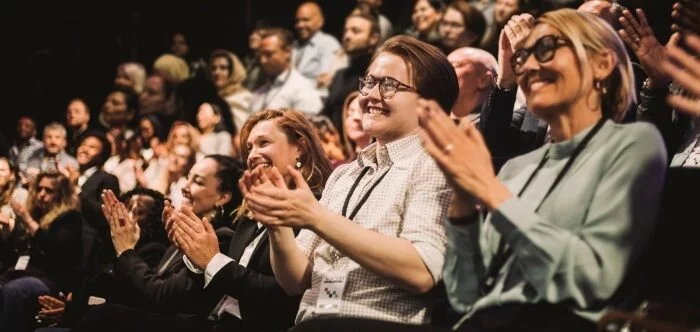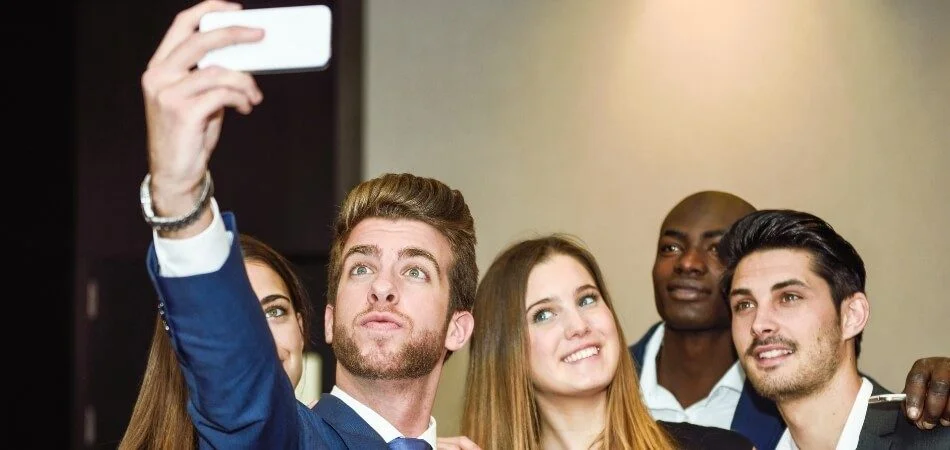Capturing the essence of a conference through photography can be both exciting and challenging. Often, attendees miss out on preserving these memorable moments due to inadequate preparation or technique. So, “How do you take good pictures at a Conference?”
To take good pictures at a conference, use natural light when possible, focus on capturing candid moments, avoid excessive zoom, and use a tripod for stability. Pay attention to composition and don’t forget to engage with speakers and attendees for unique shots.
Ready to elevate your conference photography skills? Dive into our comprehensive blog and start snapping incredible pictures that tell a compelling story of your conference experience!
A Brief Summary of Conference Photography
Conference photography involves capturing key moments and participants during conferences, seminars, and corporate events. Skilled photographers use professional equipment to document speakers, attendees, and the overall atmosphere.
These photographers employ various techniques to capture candid shots and pose group photos, ensuring a well-rounded coverage of the event. They focus on details like speaker expressions, audience engagement, and networking interactions to convey the event’s essence.
High-quality conference photos not only serve as valuable marketing materials, promoting future events and engaging attendees, but they also capture the essence of the moment, enticing others to join global conferences in experience the excitement firsthand.
Rules and Policies of Conference Photography
Conference photography is not just about taking pictures; it also involves adhering to specific rules and policies to ensure a successful and respectful experience for all involved. These guidelines are essential to maintain the integrity of the event and to protect the rights and privacy of attendees and speakers.
Consent and Privacy
When it comes to obtaining consent, it’s important to use clear and concise language. Attendees should understand how their photos will be used. Privacy concerns should be addressed, and attendees should have the option to opt out of being photographed if they wish.
Professional Conduct
Maintaining a professional demeanor means arriving on time, dressing appropriately, and communicating clearly with event organizers. Avoid obstructing the view of attendees and refrain from engaging in distracting activities while capturing moments.
No Disturbance
To capture moments discreetly, photographers can use cameras with silent modes and avoid bright flashes that could disrupt sessions. They should be mindful of their positioning to avoid blocking the audience’s view.
Copyright and Usage Rights
Photographers must understand who owns the rights to the photos taken during the conference. Event organizers may require photographers to grant them specific usage rights. Clarify these terms in the contract to avoid any future disputes.
Respect for Speakers
While photographing speakers, obtain their permission for close-up shots, and be discreet when moving around the stage. Avoid capturing unflattering or candid moments unless it’s within the agreed-upon guidelines.
Prompt Delivery
Timely delivery of photos is essential. Discuss the expected turnaround time with event organizers and ensure you have the necessary equipment and software to process and deliver the images efficiently. This helps organizers capitalize on the photos for marketing and documentation purposes.
Conference photography isn’t just about snapping photos. It’s about respecting privacy, being professional, and handling copyrights. Being discreet while capturing speakers and delivering photos promptly is also key to success.
Essentials You’ll Need to Capture Photos at a Conference
Capturing memorable photos at conferences requires more than just a camera. To excel in this role, you’ll need specific equipment and tools to ensure your photography is on point.
- Camera Gear: Invest in a DSLR or mirrorless camera with a variety of lenses, including a versatile zoom lens for flexibility and a fast prime lens for low-light conditions.
- Tripod: A sturdy tripod ensures stability for sharp images, especially in low-light situations or when capturing long exposure shots. Consider one with adjustable legs for various heights.
- Lighting Equipment: Portable lighting, such as spotlights or LED panels, allows you to control and enhance the quality of your photos, particularly in poorly lit conference rooms.
- Memory Cards and Batteries: Have ample storage with multiple high-capacity memory cards to avoid running out of space during the event. Carry extra camera batteries to ensure uninterrupted shooting.
- Lens Cleaning Kit: Dust and smudges can affect image quality. Keep a lens cleaning kit with microfiber cloths and cleaning solution handy for quick maintenance on the go.
- Notepads and Pen: Take notes of important details like session names, speaker names, and any specific photo requests from event organizers or attendees. This will help you organize your shots more effectively and capture key moments.
Being well-prepared with the right camera gear, tripod, lighting equipment, memory cards, lens cleaning kit, and notepads will not only help you capture outstanding photos at conferences but also ensure you are ready for a wide range of photography scenarios, assisting you in taking better photos at a conference.
How Do You Take Good Pictures at a Conference?
Capturing stunning photos at a conference requires a thoughtful and strategic approach that combines technical expertise with interpersonal skills. Here’s a step-by-step guide on how do you take good pictures at a conference to help you seize the essence of the event in your pictures.
Step-1. Utilize Natural Light
Make the most of natural light sources such as windows or well-lit areas by positioning yourself strategically. Adjust your camera settings to optimize exposure, ensuring that your subjects are well-lit while maintaining a balanced background.
Step-2. Focus on Candid Moments
Candid shots are powerful storytelling tools. Seek unscripted moments that reveal genuine emotions, interactions, and the atmosphere of the conference. Capture speakers in animated discussions, attendees engrossed in learning, or participants networking informally.
Step-3. Avoid Excessive Zoom
Instead of relying heavily on Zoom, physically move closer to your subjects whenever possible. Excessive zoom can result in image distortion and lower quality. If you need to zoom, consider investing in quality telephoto lenses to maintain image clarity.
Step-4. Use a Tripod for Stability
Ensure your photos are consistently sharp and steady, especially in challenging lighting conditions, by using a tripod. It minimizes camera shake and allows for longer exposures, which can help capture ambiance in dimly lit well-organized conference rooms.
Step-5. Mind Your Composition
Compose your shots thoughtfully by considering elements like framing, leading lines, and the rule of thirds. Experiment with different angles and perspectives to add depth and visual interest to your photos. Be aware of distracting elements in the frame and adjust your position accordingly.
Step-6. Engage with Speakers and Attendees
Building a rapport with speakers and attendees can lead to unique and candid photo opportunities. Engage in conversations, ask for permission when necessary, and be respectful of their space. Establishing trust can result in more authentic and compelling shots.
Step-7. Continuous Learning
Keep improving your photography skills by reviewing your work, seeking feedback, and learning from experienced conference photographers. Stay updated with the latest photography techniques and equipment to enhance your abilities.
Taking exceptional photos at a conference requires a combination of technical skills, creativity, and social finesse. By following these steps and continuously refining your craft, you can capture memorable moments that authentically represent the event’s atmosphere and essence.
Things to Consider While Taking Picture at a Conference
Capturing compelling photos at a conference requires meticulous attention to various critical factors, ensuring your images truly reflect the event’s essence. To achieve this, consider the following essential elements:
Event Schedule and Agenda
Thoroughly review the conference schedule and agenda. Identify keynote speakers, breakout sessions, and key moments you need to document. Arriving early at specific locations can help you secure prime shooting spots.
Lighting Conditions
Evaluate the venue’s lighting conditions ahead of time. Consider the interplay between natural light, fluorescent bulbs, and spotlights. Adjust your camera settings and carry appropriate lighting equipment to compensate for challenging conditions.
Composition and Framing
Master the art of composition and framing. Apply the rule of thirds, leading lines, and symmetry to create visually striking shots. Eliminate background distractions to direct the viewer’s focus toward your subject.
Camera Settings
Tailor your camera settings for optimal results. Use a wide aperture (low f-number) for striking portraits that blur the background (bokeh). Conversely, select a smaller aperture (higher f-number) for group shots to ensure everyone remains in sharp focus.
Engagement and Interaction
Forge connections with speakers and attendees. Engage in conversations during the sessions you’ve chosen, as choosing the best sessions to attend at a conference can lead to capturing authentic, behind-the-scenes glimpses of the conference’s atmosphere.
Backup Equipment and Accessories
Always have backup equipment and accessories readily available. Carry extra fully charged batteries, multiple high-capacity memory cards, and a range of lenses to tackle various shooting scenarios. This proactive approach ensures you’re well-prepared for unforeseen technical glitches.
Capturing great conference photos means planning, adjusting to light, framing well, setting your camera right, interacting, and having backup gear. This approach ensures meaningful images that capture the conference’s essence.
Taking Good Pictures at a Conference – How Does It Benefit You?
Capturing good pictures at a conference is more than just a creative outlet. It allows you to document important moments and share experiences. Quality images can elevate your professional profile and showcase your skills.
Enhance Networking Opportunities
Good photography can help you connect with others at the event. When you share your photos, attendees may recognize themselves and reach out. This opens doors for conversations and networking. Building relationships through shared interests is valuable in any field.
Create Lasting Memories
Photographs serve as tangible reminders of your experiences at the conference. They help you recall important sessions and conversations. Looking back at these images can inspire future endeavors. Sharing memories with colleagues fosters a sense of community.
Improve Your Skills
Taking pictures at a conference challenges your photography abilities. You learn to adapt to various lighting conditions and environments. Experimenting with different angles and compositions enhances your creativity. Continuous practice leads to improvement and confidence in your skills.
Boost Your Online Presence
Posting conference photos on social media can increase your visibility. Engaging content attracts followers and enhances your professional image. Your photos may lead to new connections and opportunities. Sharing valuable experiences highlights your involvement in the industry.
Document Key Moments
Capturing essential moments allows you to document the conference’s highlights. You can create a visual narrative that tells a story. Including images of conference giveaways and freebies can add excitement to your documentation. These images can be used in presentations or reports, reinforcing your role and contributions at the event.
Conclusion
Mastering conference photography is a blend of technical expertise, creativity, and communication. The articles provide insights on “How do you take good pictures at a conference?” covering essentials from lighting to engagement with attendees.
To excel in conference photography, one must harness the power of natural light, focus on candid moments, and employ equipment effectively. By following the expert guidance provided, you can elevate your photography skills and capture the essence of any conference.
Understanding the event’s schedule, adapting to various lighting conditions, and connecting with speakers and attendees are key to creating meaningful images. With the right preparation and continuous learning, you can master the art of conference photography and ensure that every moment is beautifully preserved.








